2nd December 2007
 Tuesday, December 4, 2007 at 09:55PM
Tuesday, December 4, 2007 at 09:55PM Another day of sporadic drizzle, but I do think it’s starting to dry out inland for we are starting to see antelope down by the river again: today there was a herd of waterbuck drinking downstream, and the impala were on the sandbank. Even the birds are starting to come back to the bird table after an absence of a few weeks while there were presumably just so many insects around, that they couldn’t fit in even just one more mouthful.
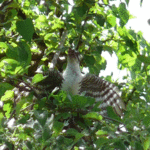
Displaying Diederik Cuckoo
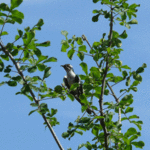
Iridescent green...
The Diederik Cuckoos, which are inter-Africa rain migrants – basically they follow the rain, wherever it may be falling – were racing around, chasing each other, displaying by opening and flapping their wings and making a raucous noise. They were so quick, flitting in and out of the bushes that it was difficult to get any decent photos of them, but I did get a couple of shots. The green colour on their backs is so incredible - like a deep forest iridescent green - almost like that of a sunbird, the way it dazzles in the sunlight.
We saw the Somali Buntings again today, and also added another couple of new birds to the list: the Harlequin Quail (newly arrived from Russia, I think) and the melodious Pink-breasted Lark, sitting high in a tree and singing its heart out. The other melody-makers of the bushland, the Rosy Patched Bush Shrikes were also in fine fettle this evening, singing out across the green landscape. The Impala were in high spirits, chasing each other playfully (and gracefully), which got the Helmeted Guinea Fowl going too, rushing around after each other at great speed, kicking up the dust.
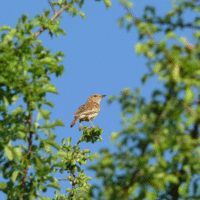
Pink-breasted Lark: songster
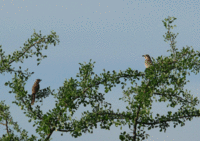
Rosy-patched Bush-shrikes: melody-makers

Racing Guineas
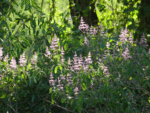
erythrochlamis: violet beauties
It made me laugh, because the so-called “mystery creeper” I have been observing ever since I noticed its expectant buds the other day, flowered today, and turned out to be none other than a familiar thunbergia guerkeana. This creeper with its gorgeous large white flowers which open at night (but you can catch them early evening and morning too) is starting to blossom across the property. Being a night-bloomer, it is pollinated by moths. The erythrochlamis spectabilis with its floral candelabra are also blossoming, and coating the bushland in violet.
VERY LATE:
The river came down in flood a few minutes before midnight. I heard the roaring of the water just as I was going to bed, and sure enough, a quick shine of my torch confirmed my suspicion. I shone the torch towards the mouth of the Mtito River, where it joins the Athi and where crocodiles seem to seek refuge from the torrent. At least 10 pairs of red eyes shone back at me. Crocodiles are so easy to spot at night, for their eyes glow red in torchlight – indicating too that they can see at night. Any animal which has reflective eyes can see in the dark – unlike primates (including humans) whose eyes are not adapted for night vision.






Reader Comments